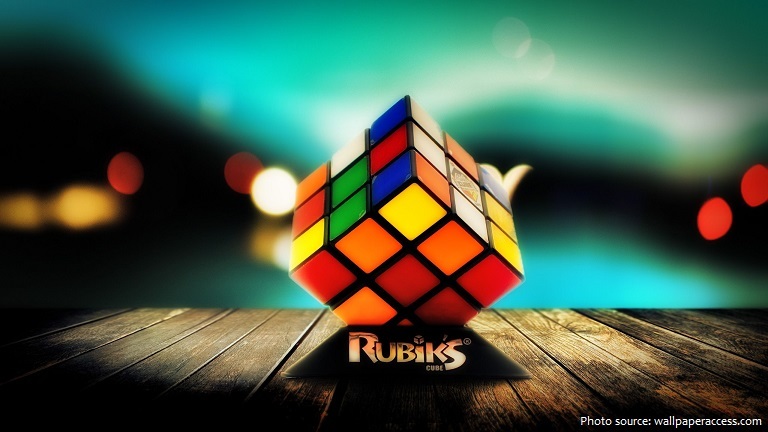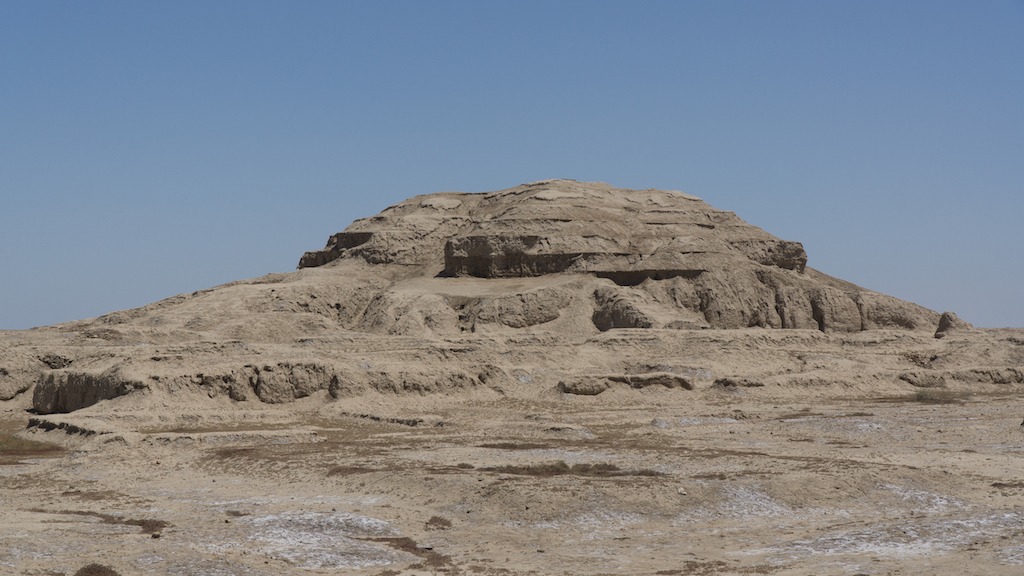Yes I did own one and did solve it over time. It was a great way to break away from the complexity of life without watching TV. Below are some interesting facts on the Rubik's Cube from Interesting facts:
"The Rubik’s Cube is a cube-shaped puzzle that has nine, smaller squares on each side.
When taken out of the box, each side of the cube has all the squares the same color. The goal of the puzzle is to return each side to a solid color after you have turned it a few times.
It has six solid colors: white, red, blue, orange, green, and yellow.
In models as of 1988, white is opposite yellow, blue is opposite green, and orange is opposite red, and the red, white, and blue are arranged in that order in a clockwise arrangement. On early cubes, the position of the colours varied from cube to cube.
An internal pivot mechanism enables each face to turn independently, thus mixing up the colors. For the puzzle to be solved, each face must be returned to have only one color. Similar puzzles have now been produced with various numbers of sides, dimensions, and stickers, not all of them by Rubik.
The Rubik’s Cube has more than 43 quintillion possible configurations (43,252,003,274,489,856,000 to be exact).
It was invented in 1974 by Hungarian sculptor and professor of architecture Ernő Rubik.
In the mid-1970s, Ernő Rubik worked at the Department of Interior Design at the Academy of Applied Arts and Crafts in Budapest.
Originally called the Magic Cube, the puzzle was licensed by Rubik to be sold by Ideal Toy Corp. in 1980 via businessman Tibor Laczi and Seven Towns founder Tom Kremer.
Although it is widely reported that the Cube was built as a teaching tool to help his students understand 3D objects, his actual purpose was solving the structural problem of moving the parts independently without the entire mechanism falling apart. He did not realise that he had created a puzzle until the first time he scrambled his new Cube and then tried to restore it.
Rubik applied for a patent in Hungary for his “Magic Cube” (Bűvös kocka in Hungarian) on 30 January 1975, and HU170062 was granted later that year.
The first test batches of the Magic Cube were produced in late 1977 and released in Budapest toy shops. Magic Cube was held together with interlocking plastic pieces that prevented the puzzle being easily pulled apart, unlike the magnets in Nichols’s design.
The puzzle was originally advertised as having “over 3,000,000,000 (three billion) combinations but only one solution”. Depending on how combinations are counted, the actual number is significantly higher.
By 1979, Hungary agreed to share the cube and Rubik signed with the Ideal Toy Corporation. As Ideal Toys prepared to market the Magic Cube to the West, they decided to rename the cube. After considering several names, they settled on calling the toy puzzle “Rubik’s Cube.” The first Rubik’s Cubes appeared in Western stores in 1980.
By 1981, Rubik’s Cube had become a craze, and it is estimated that in the period from 1980 to 1983 around 200 million Rubik’s Cubes were sold worldwide.
In March 1981, a speedcubing championship organised by the Guinness Book of World Records was held in Munich, and a Rubik’s Cube was depicted on the front cover of Scientific American that same month.
In June 1981, The Washington Post reported that Rubik’s Cube is “a puzzle that’s moving like fast food right now … this year’s Hoola Hoop or Bongo Board”, and by September 1981, New Scientist noted that the cube had “captivated the attention of children of ages from 7 to 70 all over the world this summer.”
As most people could solve only one or two sides, numerous books were published on solving Rubik’s Cube. At one stage in 1981, three of the top ten best selling books in the US were books on solving Rubik’s Cube.
Rubik’s Cubes continued to be marketed and sold throughout the 1980s and ’90s, but it was not until the early 2000s that interest in the Cube began increasing again.
Although precise figures are unobtainable, it seems that more than 400 millions Rubik’s Cubes have been sold to date, making it one of the most popular puzzles of all time.
Speedcubers try to solve Rubik’s Cubes as quickly as possible, sometimes in organised tournaments. The current record is 4.22 seconds.
The largest Rubik’s Cube is 2.503 m x 2.505 m x 2.502 m and was achieved by NINA MALL (China) in Hong Kong SAR, China on 28 March 2021.
A mere 5.6 mm (0.22 in) wide, this minuscule cube was created by Tony Fisher (UK). But despite its diminutive size, it can be operated like a normal Rubik’s Cube, albeit with the use of tweezers. The cube – which can easily be balanced on a fingertip – was produced from frosted plastic using a multi-jet modelling 3D printer. The cube was completed on 7 June 2010 and revealed on 10 June 2010.
The most expensive Rubik’s Cube is known as the Masterpiece Cube. It was created in 1995 by Diamond Cutters International to commemorate the 15th anniversary of the puzzle becoming popular internationally. It is estimated to be valued at a staggering $2.5 million, and is a part of the Beyond Rubik’s Cube exhibition. The cube is crafted from a combination of amethyst, emeralds, and rubies, all set in 18-karat gold. As this cube is made from jewels and precious stones, it is important to handle it with care. Though it can be solved like any other regular cube, rough handling may cause damage to this bejeweled Rubik’s cube.
Many different variants of the Rubik’s Cube have been made over the years – including Cubes with raised surfaces for the blind.
The cube also inspired numerous artworks and films, and spawned a competitive sport called speedcubing that fills arenas with teenagers racing to complete the puzzle in the shortest amount of time.
Since 1980, the Rubik’s Cube has been featured in films from The Amazing Spider-Man and Being John Malkovich to The Machinist and WALL-E. It has also become a way of describing other designed objects, including modern buildings, that have something not so much of the look as of the interlocking complexity of the Rubik’s Cube."
Reference: http://justfunfacts.com/interesting-facts-about-the-rubiks-cube/

I have lost a lot of faith with the Medical Community and the Governments over the last several years, but there are a few good things that can raise above the corruption and the pushing of drugs a new approach to heal people. The following is from www.gaia.com and written by Hunter Parsons that does not involve any drug or pushing an ineffective so called vaccine that the drug company is not held accountable in any way but they use sound! The use of sound can regrow bone tissue! Here is the story:
"The future of regenerative medicine could be found within sound healing by regrowing bone cells with sound waves.
The use of sound as a healing modality has an ancient tradition all over the world. The ancient Greeks used sound to cure mental disorders; Australian Aborigines reportedly use the didgeridoo to heal; and Tibetan or Himalayan singing bowls were, and still are, used for spiritual healing ceremonies.
Recently, a study showed an hour-long sound bowl meditation reduced anger, fatigue, anxiety, and ...
Not a fan of a Defense Agency studying Anti-Gravity and other Exotic Tech, but if the commercial world and make this technology cheap that will change our world yet again. The following is about three minute read and from www.gaia.com. The below was written by Hunter Parsons:
"Wormholes, invisibility cloaks, and anti-gravity — it’s not science fiction, it’s just some of the exotic things the U.S. government has been researching.
A massive document dump by the Defense Intelligence Agency shows some of the wild research projects the United States government was, at least, funding through the Advanced Aerospace Threat Identification Program known as AATIP.
And another lesser-known entity called the Advanced Aerospace Weapons System Application Program or AAWSAP
The Defense Intelligence Agency has recently released a large number of documents to different news outlets and individuals who have filed Freedom of Information Act requests.
Of particular interest are some 1,600 pages released to Vice News, which ...
As our technology gets better we are discovering more about the history of mankind and pushing the timeline back further and further. The following article is from www.gaia.com and written by Michael Chary that discusses this new find that changes the historical timeline:
"Over the past decade, there have been a number of archeological revelations pushing back the timeline of human evolution and our ancient ancestors’ various diasporas. Initially, these discoveries elicit some resistance as archeologists bemoan the daunting prospect of rewriting the history books, though once enough evidence is presented to established institutions, a new chronology becomes accepted.
But this really only pertains to the era of human development that predates civilization — the epochs of our past in which we were merely hunter-gatherers and nomads roaming the savannahs. Try challenging the consensus timeline of human civilization and it’s likely you’ll be met with derision and rigidity.
Conversely, someone of an alternative...
Not sure if you have heard of a show on YouTube called "The Why Files". If not you should check it out it is interesting and has some humor with it on different subjects. Last weeks was on a different theory how the Universe works and how main stream Science is attempting to shut it down like is always seems to do if it goes aguest some special interest. Today it is akin to what happened to those who questioned the Earth was the Center of the Universe that main stream so called Science all believed during the Renaissance period, They called any theory that the Earth was not the Center of the Universe misinformation. Does this sound familiar today? People laughed and mocked people like Leonardo da Vinci, Nicolaus Copernicus, Georg Purbach as crack-pots, conspiracy theorists, nut-jobs and they were suppressed and even imprisoned for their radical thoughts and observations. Again it sounds like today in so many ways. In any event this is a good one to ponder and see even if a bad idea ...
Seemingly chaotic systems like the weather and the financial markets are governed by the laws of chaos theory.
We all have heard about chaos theory, but if you have not or have forgotten what chaos theory is well here you go from interestingengineering.com:
"Chaos theory deals with dynamic systems, which are highly sensitive to initial conditions, making it almost impossible to track the resulting unpredictable behavior. Chaos theory seeks to find patterns in systems that appear random, such as weather, fluid turbulence, and the stock market.
Since the smallest of changes can lead to vastly different outcomes, the long-term behavior of chaotic systems is difficult to predict despite their inherently deterministic nature.
As Edward Lorenz, who first proposed what became commonly known as the Butterfly Effect, eloquently said, "Chaos: When the present determines the future, but the approximate present does not approximately determine the future.""
You may have heard the term about chaos theory as a butterfly flaps its wings in Brazil,...
I for one have lost trust in Medical Doctors due to COVID and reflection that they seem to push pills for everything and untested so called vaccines that is using a unproven technology because the Government and the Medical Boards of the State told them to. There are a very few exceptions. Thus they do not address the key problem just prescribe more and more pills to keep you alive an sick longer for them and Big Phama to profit from you. Will AI do any better? Well that depends on what was used for the training of AI. If it also pushes pills and vaccines without question then you have the same problems noted above. However, if the AI Training includes all possible forms of treatment and they zero in on the right issues for the true problem then there is possibilities they would be way better than most of the current Medical Doctors today.
The following is from an article from interestingengineering.com and written by Paul Ratner:
"A new study looks at how accurately AI can diagnose patients. We interview the researcher, who weighs in on AI's role ...






















